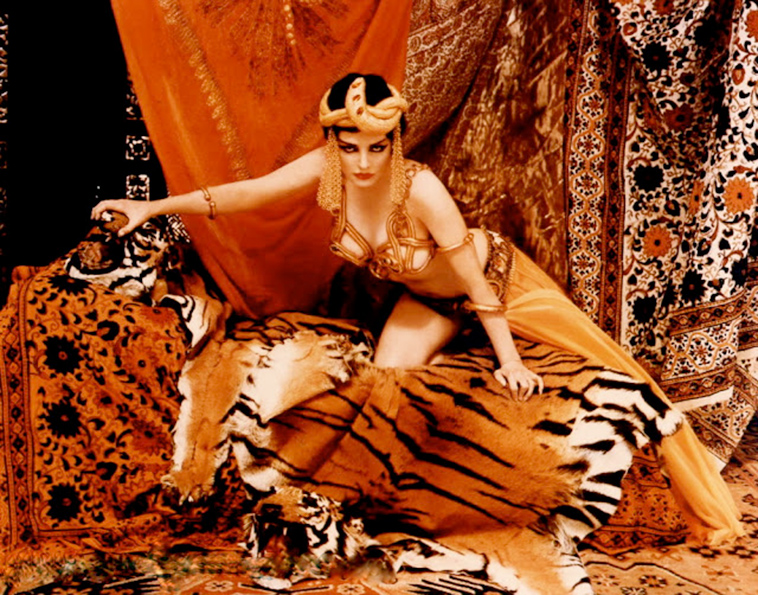"Some singers indulging in curses, Though sinful, have spendidly sinned;
But my would-be maleficent verses, Are nothing but wind."
Algernon Charles Swinburne (1837-1909)
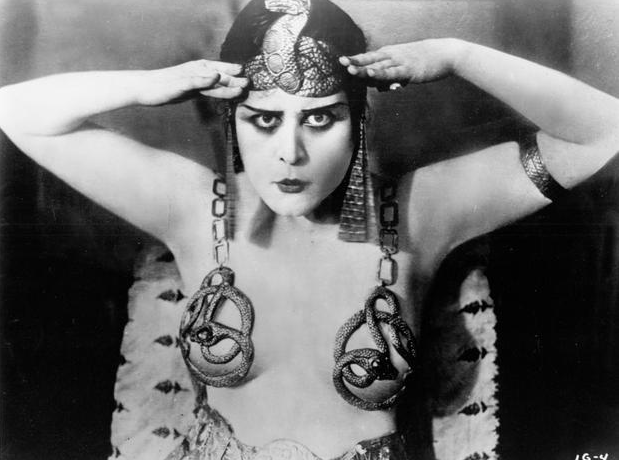
Theda Bara is known today as the first screen sex symbol. This is not really true as by the time she made her first starring role in 1915 there had already been several successful film sirens but while most of them have been forgotten by all except a few film historians, Theda remains. Staring out at us with her raccoon eyes, pale skin and pouting lips, clad in her chainmail bikini, teardrop earrings and festooned with skulls and snakes. She remains the patron saint of every bad girl from Elizabth Taylor's "Cleopatra" to Princess Leia and her gold bikini to any number of Goth Chicks, Suicide Girls and Vampires. Theda may not have even been the most beautiful of the starlets of the 1910's but that was not what she was selling. Audery Munson sold titillation, Clara Kimball Young and Evelyn Nesbitt sold scandal, Alla Namizova, Olga Petrova and Geraldine Farrar sold glamour and sophistication, Mary Miles Minter sold virginal innocence, Olive Thomas was the pretty, perky girl-next-door and Florence LaBadie, a truly timeless beauty, was a wholesome, stunning, girl across the street. But Theda didn't really sell beauty or glamour, she sold danger. And that was the sexiest of them all. At least until audiences decided she wasn't scary anymore.
The archetype of the female seductress luring men to their doom is as old as the sirens and harpies of Hellenic myths to the Biblical Eve, Bathsheba, Jezebel and Salome to actual historical figures like Cleopatra, Messalina and Renaissance figure Lucrezia Borgia and has always been celebrated in art and literature, especially in the Romantic Era. However the Vamp was a specific product of Victorian Era Britain and America where the prim and proper Victorians existed alongside the Pre-Raphaelite painters of the 1850's, Gothic and Sensation writers of the 1870's & 80's and early Art Nouveau schools of the Gay Nineties. By that time Bram Stoker's 1897 novel and later play "Dracula" gave the name "Vamp" to describe a predatory person who sucks the life from it's victim and then discards them. Stoker's original Dracula was not initially seen in sexual terms, even by Stoker who described him as a repulsive, grey, dried-out, rat-like figure closer to Max Schreck's alien Nosferatu than Bela Lugosi or Christopher Lee's coldly suave Dracula. But others swiftly picked up on the sexual themes and possibilities of the vampires need to feed and hypnotic powers. And while Dracula himself was obviously male there was no reason there couldn't be female vampires and indeed the novel did have them in the form of Dracula's Brides. While they were minor characters who only showed up for one scene, Dracula's harem inspired artists and even poet Rudyard Kipling, the normally respectable voice of the Anglo Imperialist establishment to pen an ode "The Vampire" to them thus popularizing the term.
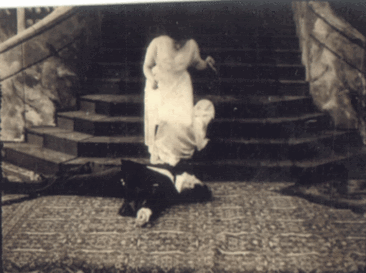
Coincidentally the Victorians also became fascinated with Classical and Biblical figures like Cleopatra and especially Salome who was championed by the likes of writer Oscar Wilde, who wrote a scandalous play based on her which was illustrated by the always provocative artist Aubrey Beardsley and made into an opera by the German Richard Strauss and then a ballet by the Russian Mikhail Fokine. The often banned play had all the elements for scandal; sex, murder and revealing costumes while at the same time winking at Victorian morality by having Salome get her comeupance at the end. Plus as it was actually a Biblical story it could be presented as upholding Victorian morality while at the same time flouting it. "Salome" also had another ingredient of the Vamp character; exoticism. The Vamp was always seen as a foreign presence, mysterious and thus both enticing and threatening; Salome, Cleopatra, Messalina, Jezebel, Bathsheba and Boudicca were all figures from the pre-Christian world and thus from it's morality and could also be presented in revealing costumes that no Victorian woman would ever wear. Besides these ancient figures even contemporary women could be Vamps if they were sufficiently foriegn enough to be exotic. Belly Dancing Muslims from Turkey, Persia, Egypt and Arabia (who could also conjure up images of the harem), Asians from China, Japan and Java, Gypsies (who were also considered to have magical powers), Native Americans, oddly white skinned African Princesses and hot-blooded Latin Women or Slavic Princesses could all be Vamps. Even Anglo white women could be Vamps as long as they dressed in a suitably "exotic" and sinful way.

SALOME BY AUBREY BEARDSLEY
Salome was the most popular of these Vamps and would be played on stage originally by French actress Lina Munte who was actually well into her forties and rather matronly but she retired from the stage for health reasons and died in 1909 missing the chance to make any films. Salome was soon taken up by more obviously sexualized and scandalous figures including Mata Hari (who incorporated Salome's "Dance Of The Seven Veils" into her act) and Maud Allen. Mata Hari's story is well known but Maud Allan was perhaps a more interesting and influential figure to our story. Born in staid Toronto, Canada in 1873 as Beulah Maud Durrant she moved while still a child with her family to San Francisco where she made a living as a music teacher and illustrator. However after her older brother Theo Durrant was executed for raping and murdering two women in 1898 she would change her name and move to Europe where she took up dance in spite of having no formal training. She picked up on the Salome character and developed an act based on the Dance Of The Seven Veils and the severed head of Jakkonen along with a skimpy costume that had a probably not coincidental appearance to that of Mata Hari. She performed throughout Europe including in Britain in spite of the fact that the Wilde play "Salome" had actually been banned (she got around the ban by only performing dance routines rather than the full play, with the blessings of the Wilde estate). Besides causing a stir with her suggestive dancing and costume, which like Mata Hari she promoted with a series of racy postcards, she caused much tut-tutting with rumours of her own sexuality and support of women's suffrage. While Mata Hari and Maud Allan were both Edwardian sex symbols with a similar appearance and played similar characters Allan was a more provactive figure and while she avoided Mata Hari's tragic fate, World War One would destroy her too. Allan's downfall was brought about by an MP named Noel Pemberton Billing, a type of figure well-known to us today; a demagogue politician using jingoism and wild conspiracy theories, who published article in his own magazine in 1918 claiming among other things that there was a secret cabal of Jews, Socialists, immigrants, lesbians and pedophiles plotting to destroy Britain and there was a "Black Book" listing their names which included the wife of Prime Minister Herbert Asquith, Oscar Wilde's publisher and Maud Allan whose dancing was meant to corrupt public morals. Allan sued Billing for libel and even though most legal observers thought him a raving fabulist she lost the case as her scandalous reputation, family history and flouting of the "Salome" ban crashed down on her and effectively ended her career. She would eventually return to America with her girlfriend where she wrote her memoirs, opened a dance school and after retiring from dance she returned to illustration to became draughtswoman in an wartime airplane factory dying in 1956 aged 83.
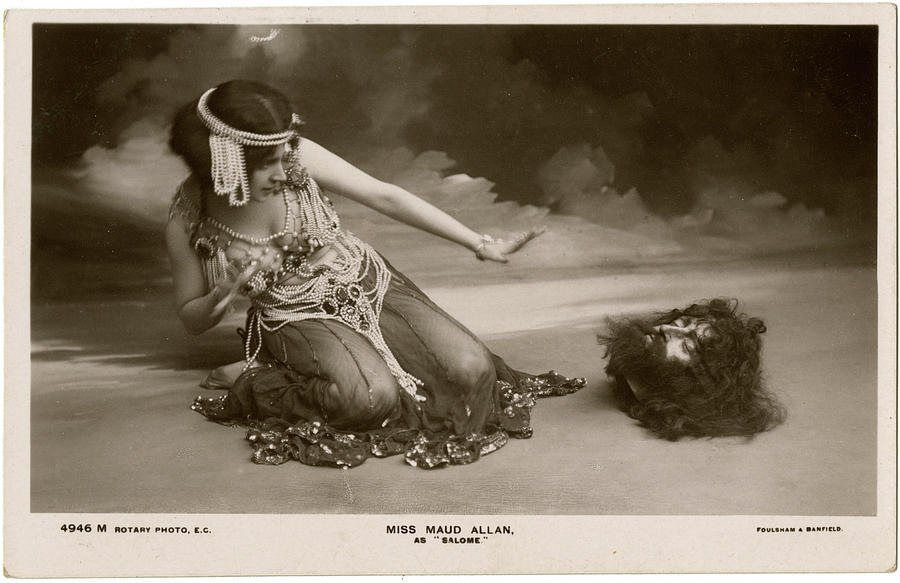
Unlike the older Lina Munte and Mata Hari, Maud Allan did manage to make at least one film in 1915 in "The Rug Maker's Daughter" a romantic adventure set in Ottoman Turkey in which she plays a dancing girl rescued from being married off to a harem and whisked off to America with Turkish assassins in hot pursuit. This film appears to be lost aside from a few stills and a plot synopsis which is a shame because it sounds like a real potboiler even aside from the significance of being Allan's only film aside from a few seconds in a pre-war newsreel in which she neither dances nor appears in costume. Salome would inevitably make her way to the screen as the greatest Vamp of all; Theda Bara.
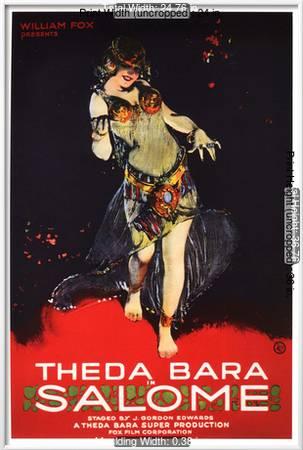
Mata Hari and Maud Allan were the real thing; independent women who had multiple affairs led scandalous lives and created their own personas. Theda Bara however was largely a creation of movie studio publicity. Theda (real name Theodosia Burr Goodman) was actually from a respectable middle-class Jewish family in Cincinnati, born in 1885, who had acted in a few small stage productions before getting a break on Broadway then was cast in a supporting role in a 1914 gangster movie "The Stain". This in turn got her cast the following year in "A Fool There Was" as The Vampire. This was not a Bram Stoker vampire however but a Vamp; a cynical, hedonistic gold-digger who seduces and destroys wealthy men for the sheer sadistic fun of it. This last factor, along with Theda's luxurious gowns and obvious stage presence made the film a success but what made it (and her) a sensation was how the studio marketed her.
To promote the film the studio produced an fantastical bio in which she was claimed as being "the daughter of an Arab sheik and a French woman, born in the Sahara." The studio also changed her name to Theda Bara which some clever sort at the studio discovered was an anagram for Arab Death but was most likely simply a shortening of her first name Theodosia and her middle name Burr, and claiming she was a mysterious figure from the Egypt who had studied the occult and had strange and possibly frightening power over men. Then they put on a press conference for which she was driven in a long white limo attended by muscle bound black "Nubian" guards. She arrived in full "Arab/Gypsy" costume and was ushered into a darkened room draped with heavy Persian rugs, beaded curtains, peacock feathers, hookah pipes and thick with burning incense where she reclined on luxurious cushions and answered questions from the skeptical press with cryptic jargon in a vaguely exotic accent.

Some reporters saw through the act and a few on the Broadway Beat had even known that Theda was a perfectly respectable middle-class American girl with some previous roles to her credit yet they all seem to have happily played along with the premise and the papers ran with the story of Evil Theda the Vamp. Other actresses had used similar stunts; imperious Olga Petrova portrayed herself as Russian sophisticate when she was actually a British actress named Muriel Harding while the All-American-Girl Louise Lovely was actually an Australian named Nellie Carbasse, but never had such a ruse been so over the top and carried this far. The fact that her few previous gigs on stage and in one film had been as minor supporting roles even worked in her favour as a more prominent actress would not have been able to pull off this elaborate persona. Ironically given this build-up and how her persona would progress in her first starring role she was actually not as wildly over-the-top as some of her later iconic roles. But that does not mean she didn't tear up the screen.
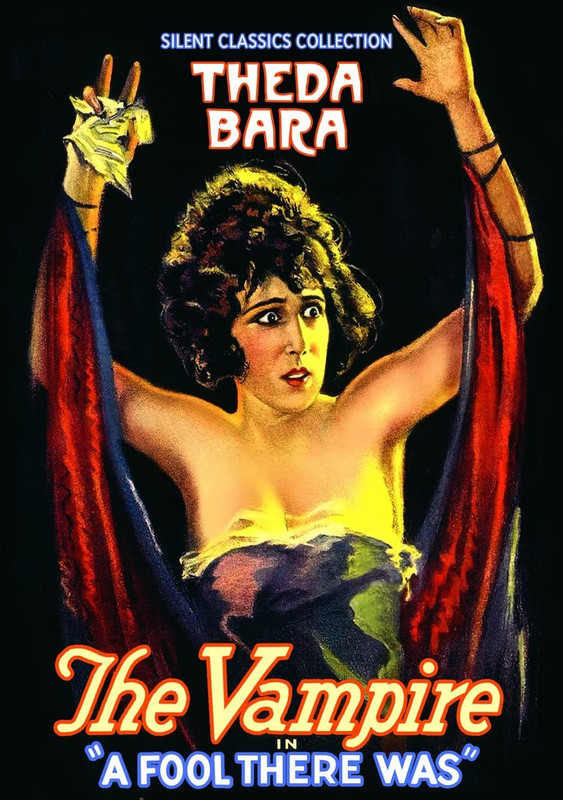
"A FOOL THERE WAS" (1915);
Directed by Frank Powell
Theda Bara ~ The Vamp
Edward Jose ~ John Schuyler, The Husband
Mabel Frenyear ~ Kate Schuyler, The Wife
May Allison ~ The Wife's Sister
Clifford Bruce ~ Tom, The Friend & May's Fiancee
Victor Benoit ~ Reginald Parmalee, The Vamp's Lover
Frank Powell ~ The Doctor
Minna Gale ~ The Doctor's Wife
Runa Hodges ~ The Child
Plot Synopsis (Spoiler alert)
After a poem intro the cast are introduced (note since most of the characters are unnamed we will use the actors names for our purposes). John Schuyler is a wealthy lawyer, happy and married with a young daughter staying at a luxurious yachting club. Theda is also living with her rich lover Parmalee who is a drunk. She runs into Edward's wife who snubs her, Theda is insulted and vows revenge. Schuyler is appointed as Special Representative to Britain but before he can go his sister-in-law May is injured in a car accident and his wife Kate must stay behind to nurse her. Theda learns from the papers of Schuyler's appointment. She is tired of drunken Parmalee and decides to leave him and seduce Schuyler. Parmalee discovers her leaving and confronts her but she lies and then steals his wallet. The next day Schuyler leaves on a ship to Europe. Parmalee discovers Theda is gone after him and goes after her in a rage. At the docks Theda runs into a shabby man working there who reveals he is a former lover and blames her for destroying his fortune and ruining his life. She laughs and has the policeman run him off. Parmalee arrives at the docks and runs into the shabby man who tells him Theda is on the ship. Parmalee pulls a gun and confronts her but she easily brushes him off saying 'Kiss Me My Fool" and he backs down then shoots himself. Tom has arrived to see Schuyler off and comes upon the bloodstained scene of the shooting and is told that Theda goaded Parmalee into shooting himself then walked away laughing. Theda spots Schuyler and after his family leaves sets out to meet him flashing a bit of ankle. He gives her a flower his daughter gave him as a farewell gift and sits with her on deck. Two months later while Kate is still taking care of May who is still recovering Schuyler is now living with Theda in Italy where they lounge around in a luxury villa and he has taken to drink. Schuyler gets a letter from Kate which Theda tears up in front of him and he tries to strangle her but she embraces him and he backs down. A friend of Schuyler's, Frank, a Doctor and his Fiancee Minna spot Schuyler and Theda in Italy in an embrace, scandalized they leave. The next day the story is in the papers which an upset May reads and tells Tom. Schuyler and Theda are at a reception where they are snubbed by the other guests, he is depressed by this but she is defiant and they leave. May and Tom confront Schuyler's secretary for information on what Schuyler and Theda are up to blasting them for covering up the affair. Schuyler writes a telegram promising to leave Theda and return home but Theda finds the letter and tosses it in the fire in front of him and he backs down. May and Tom confront Kate and tell her about the affair. Shuyler gets a letter from the US government telling him due to the scandal he has been fired but he tosses the letter in the fire and returns to Theda. Daughter Ruda prays for his return. Schuyler and Theda return to America where they are confronted by Tom and he moves her into his townhouse with his servants while Kate stays at the summer home. The servants quit rather than work for Theda. Later while driving downtown Schuyler and Theda pass by Kate and Ruda in another car. Ruda calls to him but he turns away and they drive on. Tom proposes to May and she accepts. Schuyler is increasingly depressed and worn out but Theda keeps feeding him drinks and throws parties. She is however getting impatient with his dissipation. May and Tom hold a meeting with Kate and a lawyer to convince Kate to divoce Schuyler but she refuses and Tom supports her. Six months later Schuyler is a sad decrepit drunk living alone as Theda has left him. His Secretary confronts him and quits. He tells Tom that Theda has left Schuyler. Theda is now living at another luxury hotel where she throws lavish parties with a new and younger lover. Kate is told of Schuyler's state and decides to go to him. Theda is told and goes there as well. Kate arrives with Tom and begs Schuyler, who is now old, grey and frail, to return home and he agrees but Theda arrives and kisses him and he falls at her feet. Kate leaves in tears. A week later as Kate and Ruda again pray for his return a drunken Schuyler finds Theda at one of her parties with her new younger lover and angrily throws him and the guests out and threatens Theda. Kate decides to bring Ruda to confront Schuyler at the townhouse and brings Tom. Schuyler agrees to return home but Theda is still there and again lures him back. Kate takes ruda and leaves with Tom. Schuyler sinks further into dissipation and has visions of his happy family and the death of Parmalee. He collapses and dies while Theda kneels over him laughing and pelting him with flower petals. Finis.
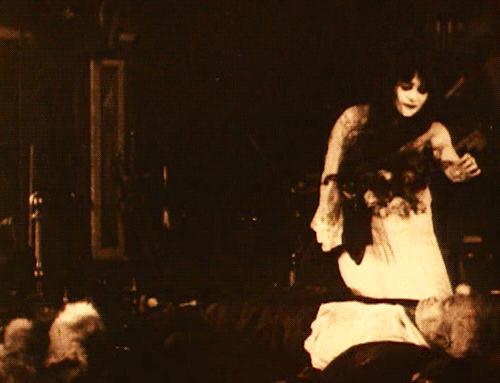
====================================================
This film is actually quite conventional and if it were not for Theda would have been long forgotten. The direction is efficient but pedestrian as is most of the acting and the story is simplistic and unrealistic. There are no shots here that really stick out in the mind other than a few of Theda. Director Frank Powell was a Canadian born journeyman who had started in theatre and already had a long career from the start of the commercial film era as an actor, writer and director working with the likes of DW Griffith and Mary Pickford and had already made over sixty films for Biograph Studios (many of them shorts of course). Powell had actually discovered Theda and cast her in a supporting role in a gangster film "The Stain". It was Powell who then spotted her talent and presence and cast her as the lead role in his next major film, a version of the successful stage play "A Fool There Was". That role had already been played on stage by Minna Gale who Powell gave a cameo in the film as the Doctor's Wife (Powell himself played the Doctor) so he could have easily given the role to Gale but Powell undoubtably figured that the fact that Theda was largely unknown would make it possible to build and entire persona around her and so it was. Theda does indeed have the presence that Powell spotted in spite of having less film and stage experience than the rest of the cast. Minna Gale (1869-1944), then 45 and perhaps now too old for the role, had been a popular stage actress since the 1880's including appearing in Shakespere plays with Edwin Booth (brother of John Wilkes Booth) one of America's greatest stage actors of the Victorian Era. Mable Frenyear (1880-1931) was a leading lady on Broadway since 1899 although this was her first film. May Allison (1890-1991) had less experience as this was also her first film although she also had appeared on Broadway. Edward Jose (1865-1930) was a Belgian actor with a stage career in Europe before coming to America where he appeared in films including "The Perils Of Pauline" as well as Powell's earlier film with Theda "The Stain". Clifford Bruce (1885-1919) was, like Powell, a Canadian who had also appeared in "The Perils Of Pauline". Even child actor Ruda Hodges already had an extensive list of film credits. Yet Theda easily dominates every time she is on screen. Despite modern assumptions about her likely acting style she is actually not wildly over-the-top, avoiding the sort of stagy emoting that some of the male actors here rely on. Edward Jose and Victor Benoit engage in plenty of the sort of cliche eye-rolling, teeth gnashing, chest clutching and clothes rending that modern audiences find campy but Theda actually does not. She relies instead on an imperious presence, a confident self-possession and flashy wardrobe much of which she apparently designed herself in all of her films. Theda's status as the first modern film sex symbol was set with this film but her modern status is based instead on the film stills from her exotic epics as Cleopatra and Salome. To modern eyes Theda here is arguably not necessarily more attractive than Mabel Frenyear or May Allison and her appeal is mostly due to her strong presence and her wardrobe. Unlike her more notorious scantily clad pin-up costumes of a few years later (for which she seems to have lost a few pounds) she is mostly dressed in full length robes with feathered hats and jewels leading to the scene where she seduces Schuyler by (gasp) showing a flash of ankle. If there was a single scene to show that this film is firmly rooted in the pre-Jazz age Edwardian Era that would be it. The outfit she wears in her first scenes with it's flashy striped slacks is actually shockingly modern for 1915 but after that her clothes are more Edwardian Bohemian. Far more shocking would have been scenes where Theda is shown in a nightie (sometimes falling off one shoulder) with her hair down and uncombed. This last look would have been scandalous to proper Edwardians as no halfways respectable woman would ever be shown with her hair down, in fact even Theda herself is never actually shown in public that way. As none of Theda's other classic films have survived we can't really know just how she acted in them but here she is actually not that campy and is relatively restrained and natural in her style making an unbelievable character somewhat real. This film is however not meant to be taken as realistic, it is instead a Victorian fable.

One of the things that made the film stand out was it's lack of a conventional moral, unlike Salome she doesn't even get her comeuppance at the end and is free to sin again. But that doesn't mean there was no moral though. The Vamp was not a realistic character that people were supposed to identify with, she was an outsider who tempted and corrupted men who strayed from their conventional bourgeois married lives. She seduced and ruined men just for the Hell of it and then sometimes (although certainly not always as here) got her comeuppance at the end or reformed. Whether she reformed or not was not really the point. A conservative audience might take some satisfaction from her being reformed to conform with their conventional attitudes but the real point of the character was to frighten the men to stay at home. This was a common fear of the Victorians as the Industrial Age took steam and the longer working hours, men working outside their immediate families and communities, sometimes with immigrants from strange lands were seen as destabilizing the traditional family. It's probably not a coincidence either that the era of the Vamp coincided with a change in women's roles as more entered the workforce and sought the right to vote and presenting the Vamp as an exotic fantasy figure who might seduce and ruin men who lacked the moral fibre to stay with their wives but would not challenge gender roles in any other way, provided an escapist catharsis along with its moral lesson. In this case it was actually better for the film's moral that the Vamp is still out there, on the prowl. Likewise it's also more useful to have the film set in the present rather than the distant past as with Cleopatra or Salome making her a present menace who could be stalking your man even now!
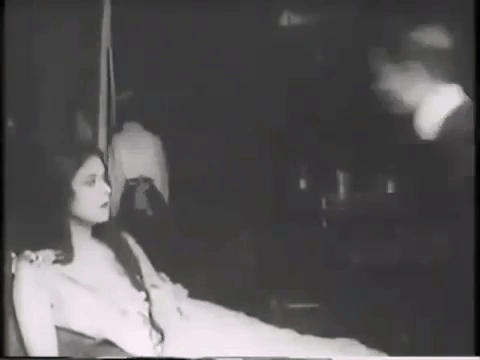
Today Theda is remembered as a sex symbol, and she is here, but besides sex there is another equally important destructive force in the film; alchohol. It has to be remembered that at the time the play was staged and the film was made (in 1909 & 1915) the campaign for prohibition in America was reaching it's apex with the 18th amendment banning trade in alcohol passing in 1919. The prohibition campaign was not a fringe Christian conservative movement but completely mainstream and fear of alcohol runs throughout the film. The male characters ruined by Theda are always shown as staggering, broken down drunks and once Scuyler is seduced by Theda he is always shown that way and frequently either drinking or being fed drinks by Theda, who oddly never seems to drink herself. The other characters are never shown drinking aside from the guests at her drunken parties at which Theda seems to be the only person who is sober and in control. Theda does use sex to lure her prey in but then it is the alcohol that destroys them, reducing them to shambling ruins within a shockingly short time. Schuyler goes from a swaggering if middle-aged authority figure to a decrepit grey haired wreck in a state of complete mental and physical collapse within just a few months. Which begs the question as to what exactly is she feeding him? Absinthe presumably, but no amount of alcohol could realistically destroy a man so quickly and thoroughly. This film constantly draws a comparison between the broken down life of debauchery Schuyler lives with Theda and the happy wholesome family he left behind. There are repeated scenes of his adorable daughter (with the intertitle helpfully informs us is "Innocent") and his long suffering wife and if that was too subtle the cute moppet is also shown literally preying for his return in a scene shot in a moonstruck silhouette for maximum maudlin effect. If that's still too subtle after we establish the wholesome family unit there is a scene of the whole family staring into a sunset as the words "The Sunset Of Happiness" pop up on the intertitle card. Then the night before Schuyler meets Theda there is yet another weather based omen in the form of a thunder and lightning storm in a film that does not otherwise have any noticeable weather. This film should not however be seen as merely a melodrama but a temperance lecture so while it is obvious to compare this film to superficailly similar films with a wanton woman like "Camille", "Carmen'' (both of whom Theda also played), the Lousie Brooks film "Pandora's Box" or Marlene Dietrich's "The Blue Angel" this film actually has a lot more in common with "Reefer Madness", albeit with more intellectual pretensions and a much better cast.
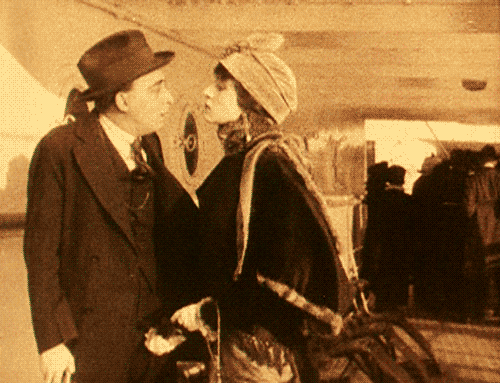
Another different theme in this film that defines it as not being based in reality is one of implied supernatural powers of Theda's Vampire who is explained as having some unexplained power to drain the life-force from men as a sort of Psychic Vampire (note the film doesn't actually say this but it's implied in the play and especially the promotional buzz around it) hence the term "Vampire". The fact that her character is never given a name also makes her more of a magical figure than a real woman, even a wanton one. She is introduced in a scene in which she admires a rose only to rip its head off and laugh. This is quickly contrasted with a scene in which the daughter pricks her finger on a rose and her mother kisses it better. Once on the ship Theda's vampire powers are shown when she deliberately places her deck chair over the bloodstain left by Parmalee's suicide. It is also implied that she may have some sort of ageless quality (Theda was actually 29 at the time) when she is confronted by her previous lover, now a broken down tramp, who mentions yet another previous destroyed ex lover. By the end of the film as Schuyler is firmly ensnared he is shown trapped behind a staircase banister as if behind bars. In a previous scene Theda is also shown behind those banister rails but she is shown confidently leaning over with her hair down as if ready to pounce. In the final scene as he lays dying she leans over him laughing with her long dark hair trailing down looking perfectly like a vampire or even better a succubus.
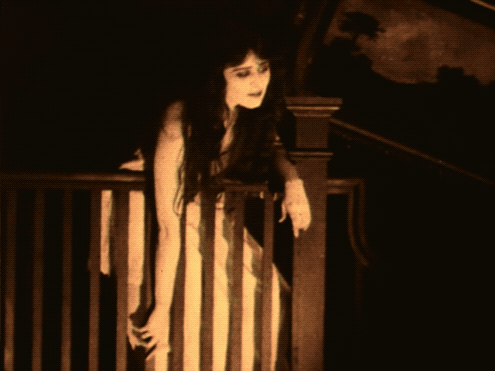
The film was an immediate smash and established Theda as a star in a persona which she proceeded to run with. If however the Vamp had been a cynical marketing ploy Theda took the character to heart. She was mocked at the time for taking herself too seriously and is largely seen that way today but showing some self awareness she understood how the character served as a cautionary tale, especially for men saying "I will continue doing vampires as long as people sin." She also noticed that her character was seen somewhat differently by women who could live vicariously through her. Noting that much of her fan mail came from such women she explained; "Women are my greatest fans because they see in my Vampire the avenging spirit of all their unavenged wrongs they have lacked the courage or willpower to redress all their grievances. And they give me the greatest compliment;"I know I should sympathize with the wife but I do not". I am în efect a feministe"
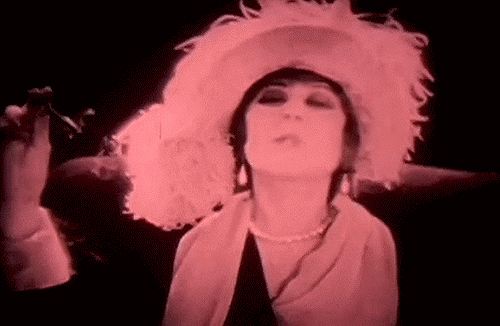
But while Theda herself was obviously fully aware of her artifice she also embraced it. Staying in character off screen, legally changing her name and taking an avid interest in tarot cards and fortune telling. She also designed many of her own elaborate costumes. Soon enough she was playing Vamp roles like Cleopatra, Salome and Carmen while starring in movies with titles like "Sin", "The Forbidden Path", "The Vixen", "The Eternal Sapho", "The She Devil" and "When A Woman Sins" and posing for photo shoots always in full regalia, usually accompanied by snakes or skulls or both. She became the archetypal Vamp, a role she plays to this day. There is a problem in accurately assessing her films and talents because even though she made over forty films only three of her starring roles have actually survived; "A Fool There Was" (1915), "East Lynne" (1916) and "An Unchastened Woman" (1925) along with her first film "The Stain" (in which she only plays a minor role) and a comedy short. All of the rest of her films were destroyed in a studio fire in 1937. This means to evaluate the rest of her film catalogue we are left with a number of titles, plot descriptions, posters and lobby cards, stills and critical reviews. Some of her films were also based on well known plays (including "A Fool There Was") and previous films or have subsequent films we can compare them to meaning we at least know their subject matter. These include the aforementioned "Salome" which had been both a play with Maude Adams (among others) and a fairly crude 1907 Italian film starring one Vittoria Lepanto and would be the subject of an oddly beautiful 1923 version by Alla Namizova. "Cleopatra" (1917) had already been played by Florence Lawrence (1908) and a successful 1912 film by Helen Gardner and would be remade as a sound version by Claudette Colbert and infamously by Elizabeth Taylor. "Carmen" (1915) was based on the opera and had been a successful film by singer Geraldine Farrar that same year. "Lady Audley's Secret" (1915) was an 1860's scandalous English novel. "The Eternal Sapho" (1916) was based on a 1881 French novel. "The Darling Of Paris" was based on the Esmerelda character from "The Hunchback Of Notre Dame" which had already been the subject of a 1911 French film and would be famously remade as the 1923 Lon Chaney classic and the 1939 Charles Laughton remake. "Camille" (1917) was based on an Alexandre Dumas novel and had been made as a play starring the finest actresses of the day; Sarah Bernhardt and Eleanora Duse and then a film several times in Europe and once in America starring Clara Kimball Young and would later be remade by Alla Namizova, Pola Negri, Erna Morena and eventually a sound version with Greta Garbo. "Madame du Barry (1917) was another Dumas novel later filmed with Pola Negri. Theda also did a version of "Romeo And Juliet" in 1916. She was hardly the only Vamp of the time with the competitors like Alla Namizova, Louise Glaum, Barbara La Marr, Virginia Pearson and Geraldine Farrar vamping up the screen while in Europe while in Europe the likes of Asta Neilsen, Pola Negri, Erna Morena, Lya De Putti and Fern Andra were doing likewise. But none of them played the role as often or with greater success than Theda. And while the likes of Alla Namizova, Pola Negri, Asta Neilsen and Erna Morena were able to branch out into different characters, Theda was never able to.
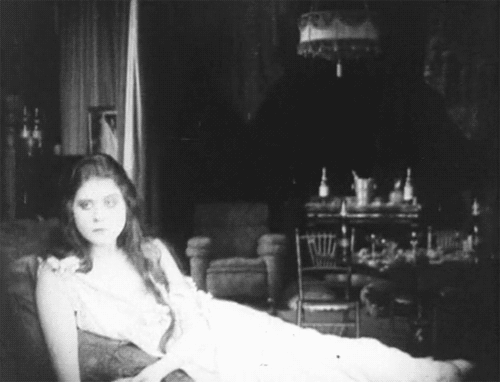
The usual assessment of Theda is that she basically kept playing Vamp characters until people got tired of them and her. However taking another look at her catalogue shows a slightly more complex story. It is true that the likes of Cleopatra, Salome and Carmen could be considered Vamps and film titles like "Sin", "The Forbidden Path", "The Vixen", "The Eternal Sapho", "The She Devil", "When A Woman Sins", "The Wolf Woman", "The Siren's Song", "The Lure Of Ambition", "Destruction" and "The Serpent" are probably self-explanatory. However Camille, while a courtesan, is more of a complex and tragic figure and Esmeralda from "Hunchback Of Notre Dame" and Juliet from "Romeo And Juliet" are clearly not vamps. One of the ironies of the terrible state of her surviving film catalogue is that of her four surviving feature film starring roles only two, her first and last actually shows her playing the Vamp while her last was a comedy Vamp parody. The other shows her attempts to diversify somewhat playing another character; the more tragic and put-upon figure of the wronged woman.

"EAST LYNNE" (1916);
Directed by
Cast;
Theda Bara ~ Lady Isabel Carlisle
Ben Deeley ~ Archibald Carlisle
Stuart Holmes ~ Captain Francis Levison
Claire Whitney ~ Barbara Hare
William H Tooker ~ Judge Hare, Barbara's Father
Stanhope Wheatcroft as Richard Hare
Emily Fitzroy as Cornelia
Plot Summary (spoiler alert);
Fredrick Severn (Frank Norcross) is an ill-tempered old rich crank in poor health, Archibald Carlyle (Ben Deely) is a young lawyer. Carlyle visits Severn who informs him he wishes to sell his estate of East Lynne to escape his creditors which Archibald wishes to buy. Francis Levinson (Stuart Holmes) is a drunken wastrel living off his uncle's allowance from which he is about to be cut-off. Isabel Severn is the single daughter of Fredrick who Archibald is attracted to. Barbara Hare is in love with Archibald. Fredrick's Brother (H Evans) has a wife (Velma Whitman) who is in turn attracted to Francis. Archibald tells Barbara about his visit to Frank Severn and she decides to go visit East Lynne herself to talk to Isabelle when Francis and Velma arrive. Isabelle entertains them on the piano. Archibald proposes marriage to Isabelle in the presence of Barbara who is jealous. Isabelle at first delays then accepts his proposal. Velma congratulates them but Francis notices Barbara's unhappiness. Several years later Isabelle and Archibald are married with two young children living happily at East Lynne. Judge Hare (William Tooker) is the father of Barbara and along with his wife (Eugenie Woodward) along with their son Richard (Stanhope Wheatcroft) who is a callow young man who has been associating with the Hallijohns, a poor family living in the woods whose daughter Afr (Ethel Fleming) he is attracted to much to the Judge's disapproval. The Judge visits Mr Hallijohn (James O'Connor) and confronts him to say that he will not allow Richard to marry Afy. Hallijohn is insulted, telling Afy she may not see Richard anymore. Later Richard goes out to deliver a hunting rifle to a friend and will cross through the woods where the Hallijohns live. Francis is also travelling through the woods and visits Afy who he has been carrying on an affair with. Richard calls upon Afy while Francis is there and she sends him away and he is so upset he leaves behind the gun. Hallijohn returns and finds both the gun and Francis with Afy. As Francis leaves Hallijohn follows with the gun and confronts him resulting in a fight in which Francis shoots Hallijohn dead and flees. This has been witnessed by Otway Bethel who then blackmails Francis for his silence. Richard and Afy both hear the gunshot and rush to the scene. Richard arrives first and picks up the gun but panics and runs away when Afy arrives seeing him. Otway shows up and blames Richard for the shooting. Later a Coroner's Inquest presided over by Judge Hare inquest finds Richard Hare guilty in absentia and a warrant for his arrest is issued. Meanwhile Richard has fled to the city. Judge Hare disowns his son and vows to have him captured in spite of his family's pleas. Francis reads about all this from the news, he is also inheriting the estate from his now dead uncle and returns to visit Archibald who is his lawyer to settle the estate. Living with the Carlyles is his sister Cornelia (Emily Fitzroy), a dour older spinster. Richard, still on the run, sneaks back home to visit his now sick mother. Barbara spots him and warns him away. Richard hides in a barn and Barbara goes to Archibald for help when Francis overhears. He goes to Isabelle and tells her that Archibald and Barbara are having an affair. She covertly sees the two of them as Archibald comforting Barbara and decides Francis is telling the truth. That evening Barbara sends a note to Archibald asking him to meet her and before going to find her Isabelle angrily confronts him and storms out. Isabelle then finds the note from Barbara. Francis tells her this confirms the affair and takes her to spy on Archibald. Meanwhile Barbara has brought her brother Richard to meet Archibald who tells him to hide in a guest house at East Lynne. Isabelle once again sees Archibald and Barbara together and assumes the affair is real. Distraught, she returns to East Lynne but does not confront Archibald. The Carlyles are invited to an important reception. Elderly Mrs Hare is now dying and asking to see her son Richard and so Barbara calls Archibald to ask him to talk to the Judge and set up a meeting. Archibald then has to cancel going to the reception and sends Isabelle instead with Francis to accompany her. While Archibald distracts the Judge, Barbara sneaks Richard upstairs to greet his mother. Meanwhile Francis convinces Isabelle to run off with him. She writes a note to Archibald denouncing him and leaves both him and their children running off with Francis. Archibald returns home and finds the note. Months later as Isabelle is living with Francis, Archibald sues for divorce which is granted in the absence of Isabelle who Francis has not told about the divorce case. She finds out by reading a letter to him from a lawyer. She has had second thoughts and decides to leave Francis by enlisting as a missionary nurse serving abroad. She leaves on a train which derails and wrecks causing loss of life. Isabelle survives but switches identities with a woman who died A letter she wrote asking for forgiveness is found and sent to Archibald who isn told she is dead. Archibald mourns Isabelle but remarries Barbara while Francis hasn't bothered to look for Isabelle and quickly finds new younger girls. Isabelle spots a help wanted ad put in the paper by the new Carlyle couple to hire a governess for the two children and decides to apply in disguise and is hired. She discovers their son is quite ill and in bed. Otway the blackmailer has read about Francis' inheritance and returns to shakedown Francis for more money. He is spotted by a detective who tails him to Francis's estate where he has been drinking heavily and having visions of the ghost of Halliwell. As Otway confronts him the detective overhears them confessing their crimes and arrests them both. Archibald's sister recognizes Isabelle and allows her to comfort her dying son. As the child dies she reveals herself. Archibald also witnesses this and as he does she collapses. She begs his forgiveness and he embraces her as she dies. Finis.
========================================================
"East Lynne" was somewhat loosely adopted from a popular novel written in 1861 by Ellen Wood as part of another Victorian genre known as "Sensation Novels". These novels which started with "The Woman In White" (1859 by Wilkie Collins) and notable works included "The Moonstone" (Wilkie Collins, 1868), Lady Audley's Secret" (1862 by Mary Elizabeth Bradon), "Great Expectations" (1860 by Charles Dickens) and the unfinished "The Mystery Of Edwin Drood" (1870 by Dickens) and had an influence on writers like Robert Louis Stevenson, Thomas Hardy, Elizabeth Gaskell, Henry James, Oscar Wilde and Joseph Conrad. Sensation Novels were known for their complex plots full of adultery, murder, bigamy, rape, suicide, disapearences, double identities, secret marriages, insanity, amnesia, forgeries, gambled away inheritances, women locked away in asylums and the use of opium and absinthe. Sometimes all in the same novel. The plots were best described as labyrinthine and relied on unlikely coincidences to keep the plot moving. The stories were often originally printed as multi part serials that could run on for months later being republished as novels if they were successful enough in their first run. These novels did not usually have happy endings and while the guilty might get punished the innocent often did as well. Unlike the earlier Gothic Romances, Sensation Novels took place in modern Britain rather than exotic foreign or historical locales, featured characters who were middle or upper middle class rather than aristocrats and usually avoided magic and the supernatural in favour of realism, albeit of a sort that we would now call a Soap Opera. Sensation Novels were not cheap exploitation however but they also outraged respectable conservative society in that by avoiding the obvious escapism and fantasy of Gothic Horror they challenged the safe, cherished Victorian ideal of the stable middle class home as well as often having complex female characters who could be both victims as well as protagonists who could initiate action. In fact two of the most successful Sensation authors, Mary Braddon and Ellen Wood, were in fact women and in turn respectable middle class women were among the most devoted fans of these novels in the way they were not for the sort of cheap, exploitative and badly written crime Penny Dreadfuls and Newgate Novels of the era which no respectable woman would be seen with. Because of all this Sensation Novels were seen as challenging the smug morality of Victorian domesticity in a way that the more fantastical Gothic Romances or trashy Newgate Novels ever did. Although written a full generation later "A Fool There Was" could be considered a Sensation Novel (or play) as well aside from it's somewhat muted supernatural subtext and the Vamp character who lacks any of the depth or complexity, or moral ambiguity of a Sensation heroine.

The first and best known of these novels, "The Woman In White" had already been made into a movie in 1912 (now lost) and would be made again in 1917 with Florence La Badie, and in 1917 by Theda's own Fox Studios (but without Theda) in another lost film. Later there would be an Austrian version (1921) and a British version in 1929 starring the American Blanche Sweet. Film versions of "Lady Audley's Secret" would be made in 1912 and a 1915 version with Theda (now lost of course) and again in 1920. So clearly Sensation Novels were considered viable film projects although they do not seem to have been all that successful as films with the possible exception of La Badie's version of "The Woman In White" which was actually released again after her sudden death in 1917 and is the only other film that has survived. Neither of Theda's two attempts were considered successful which is probably why Fox decided to go instead with the far less well known but respected stage actress Genevieve Hamper for their version of "The Woman In White" in 1917. This was not especially successful either like other Sensation adpatations which were perhaps just too complicated and slow moving to be easily filmable at least at the time, today the obvious format for these stories would be a TV miniseries and a few modern BBC adaptations of Sensation Novels have been made.

Sensation Novels were known for their overly complicated plots and the movie actually simplifies the story but it is still confusing and implausible often relying on conveniant coincidences and characters sometimes being unbelievably obtuse or gullible to forward the plot. There are also far too many characters to keep track off and some of them simply disappear. To be fair that was often true of the novels as well, in fact the movie actually simplifies the plot of the novel which included both Archibald and Francis running for Parliament and a trial and dramatic reprieve for Richard. Having Theda fake her death and return in disguise is not believable but was a standard plot twist for Sensation Novels. However, what a Victorian novel could get away with over the course of a couple hundred pages seems simplistic and manipulative in an hour plus movie in the 1910's. Theda here plays against her Vamp stereotype and is even somewhat dowdy compared to the younger Barbara Hare. This is appropriate to the character though and Theda deserves some credit for stepping outside her usual role. However, that doesn't mean the character is terribly interesting. In fact even though she is top billed Theda does not even get the most screen time and is often absent from the story which must have disappointed her fans. We are immediately informed that this Theda is no vamp in her opening scene when unlike in "A Fool There Was" she is shown ripping the head off of a flower and laughing she is shown here playing with a cute puppy and this is quickly contrasted with Francis kicking a dog out of the way and stroking a cat so he is clearly the villain. Just to further illustrate the point as his scheming increases he is shown juxtaposed with an actual snake in the grass. Theda on the other hand is often shown with her adorable children much like the Schuyler family in "A Fool There Was".The children again symbolize innocence compared to the behaviour of the adults and similarly it is notable that again the servants, although minor and nameless, see through the behaviour of their masters as Francis' butler clearly regards him with disdain. That it is the working class staff and detective (again nameless) who are the only morally aware adults in the film allows them to act as surrogates for the film's mostly working and lower middle class audience to feel superior to the wealthy protangonists which was another common theme in Sensation Novels.
Theda spends most of the movie passively wringing her hands and looking depressed which is not what her fans want or expect from her. The scenes of her in disguise are not inherently credible consisting of a wig and dark glasses but she does use her body language to show how through her depression she might be taken for a different person with her slumped shoulders and heavy movements. In fact in this film it is the oily Francis who plays the Vampish role, using and manipulating people sometimes for no obvious reason other than sheer malice while Theda plays the naive patsy. However Francis is notably lacking in the cynical self control of Theda's iconic Vamp who would not have been so easily caught, would not have allowed drink to cloud her judgement or have been haunted by the ghosts of her victims. Compared to her he's not a very impressive villain.
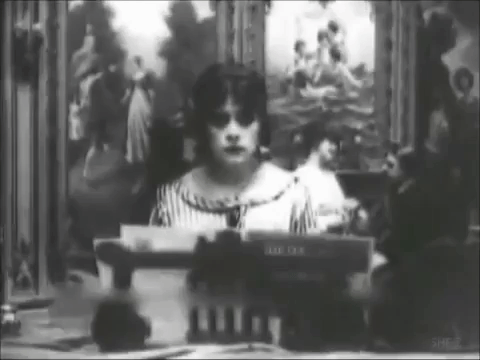
Stuart Holmes as Francis is appropriately oily but as with her other surviving films most of the other characters are fairly bland however. This is a notable difference with her contemporary Alla Namizova who also played Vamps but also usually had the foresight and confidence to have strong supporting players like Rudolph Valentino and Noah Beery and even younger and pretty co-stars like Patsy Ruth Miller. The direction from journeyman Bertam Bracken is again strictly rote aside from one shot where Francis and the blackmailer get caught and the camera pans back and forth. There are also two scenes where ghosts or visions return to haunt Francis and Barbara. How many creative choices were Theda's or the studio's is difficult to say at this point. Contemporaies Alla Namizova, Mary Pickford, Mabel Normand, Helen Gardener and Nell Shipman produced their own films and had creative control. Theda never did and seems never to have tried to do so. Instead she was content to usually play the same basic role for which she was very well compensated being one of the highest paid actresses of the 1910's during which time she made over forty films in just over four years.
UPDATE; Mere months after I wrote this some footage surfaced in Spain of two minutes from the long lost 1918 Theda version of "Salome" (later redone by Alla Nazimova). It's only a few fragments edited together in no paticular order but it does show Theda in one of her iconic costume epics and confirms as in "A Fool There Was" she can dominate the screen as a Vamp in a way that she clearly did not as a victim in "East Lynne". It also shows that part of her appeal was not just her exotic, skimpy outfits but also her wonderfully expressive face and energetic physicality when given the right role. She also clearly enjoyed exotic costumes more than the conventional outfits of "East Lynne".
FRAGMENTS FROM "SALOME" (1918);
However by the end of World War One Theda had gone from Vamp to Camp and what had seemed risque now seemed cliche. Theda's career was effectively over by 1919, the same year that the War officially ended, the Spanish Flu receeded, women got the right to vote, prohibition passed and America moved on from exotic escapism with a simplistic moral, for the moment at least, to the Jazz Age and a new female archetype and sex symbol; the Flapper. Played by the likes of Olive Thomas, Colleen Moore, Clara Bow, Corrine Giffith, Joan Crawford and Louise Brooks, the Flapper was thoroughly modern, liberated, approachable and most importantly believable in ways the Vamp never was. Crucial to the appeal of the Vamp was the audience's willingness to believe that at the mere flash of ankle and bat of an eye any man would instantly drop everything, abandon his wife, family and job to kneel at the feet of the Vamp who would then coldly use and dispose of her hapless prey just for kicks even if the audience could see, if they chose, that the Vamp was not really drop dead gorgeous or at all likable. The Vamp was a remote and intimidating figure that nobody would ever actually meet in real life while Flappers could be seen down down at the local malt shop or heading off for a night on the town. Vamps were motivated by some mysterious need to bring men to their ruin while Flappers just wanted to have a good time. The Vamp had been a boogieman warning men of the dangers of straying from hearth and home but after a bloody war and pandemic people were tired of being scared into conformity and ready to enjoy the new joys of the Jazz Age. Once the economy picked up by 1920 thus saw the creation of a new sub-culture that we now recognize; Youth Culture.

Prior to the Jazz Age there had been young people of course but there was no youth culture as we understand it. People went from school to work and marriage with little time in between. Most had little time or disposable income to spend much time cutting loose. Few people went to university and those did were wealthy sons of privilege heading for jobs in the establishment and mostly stuffy conservatives. Only a tiny minority of late Victorian Bohemians and leftists had the time, disposable income or inclination to cultivate an alternative culture although by the Edwardian Era there were some basic ingredients with non conformist art movements like Art Nouveau, Futurism and Cubism, musical movements like Ragtime, Serialism and Impressionism, flashy and colourful new fashions and new philosophies and thinkers like Marxism, Anarchism and Freud. However after the carnage of World War One and the obvious failures of leadership it exposed there was a larger desire to rebel against these Victorian holdovers. The imposition of Prohibition in America (and briefly Canada) only spurred on a sense of rebellion. A more prosperous economy actually encouraged this trend as young people suddenly had more time and money to spend on some new (or newish) inventions that were tailor made to feed into this need for speed, affordable cars (which meant young people could go out and party away from their parents) and phonographs and radios to provide a soundtrack which Jazz arrived just on time to provide. The Flapper was an important product of all this allowing girls to take more control of their leisure lives and pleasure just as their older sisters had gotten the right to vote. In all this the Vamp became an artifact of an age gone by. Young people no longer had the need to view a sex symbol through the distancing lense of extoticism or camp and they no longer had the desire to be preached to (however veiled) by their implausible plotlines and predictable moralizing.
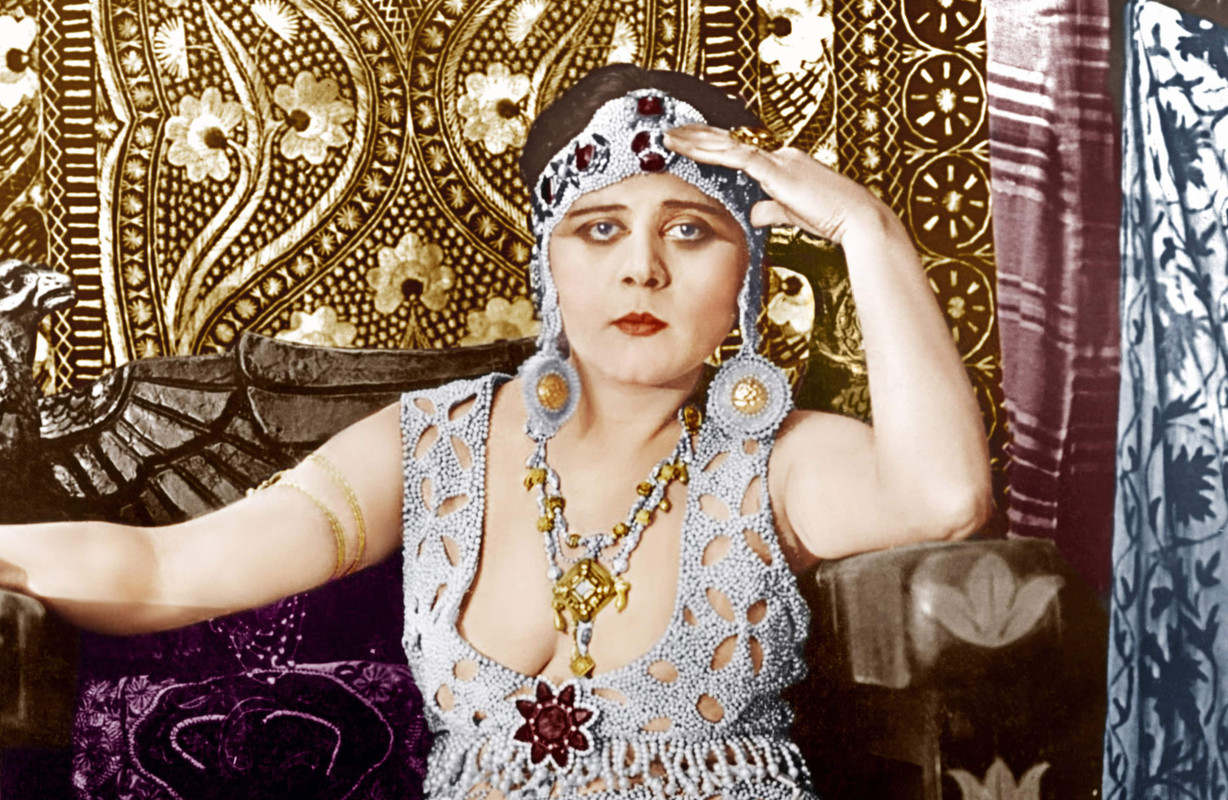
Theda had shown she was not without actual acting talent but her public persona made her uniquely ill-suited to buck changing trends or rise above them by changing her image. She was the Queen of the Vamps and could not be accepted otherwise. She also made some bad career decisions in 1919 when Fox Studios ran the numbers and decided her expensive contact wasn't worth it. Theda was not willing to take a pay cut and seems to have no longer been happy at Fox anyway with its heavy schedule of ten features a year and bored with their reluctance to allow her to take chances on different roles as Theda was the first actor to fall victim to stereotyping. In the earlier stage era actresses like Maude Adams, Lillian Russell, Mata Hari and Adah Isaacs Menken could play the same basic role, and sometimes literally the same role for years on end. But while they appeared to maybe hundreds of people a night and thousands a year a film actress could appear to millions creating an indelible impression as Theda certainly did. This made it impossible to break free from that impression as possessive fans demanded they remain the same while younger fans demanded something new. It must also be remembered that by 1919 Theda was now 34, which is not old exactly but not really young enough to play a convincing Vamp either. The apparently ageless Alla Namizova was actually five years older but with her trim dancer's body she appeared much younger and had already shown some willingness and ability to play some more diverse roles while Theda was starting to look a little frumpy to be a sex symbol. Theda seemed at times to recognize this as her attempts in a few films like "East Lynne" to branch out into the character of the tragic wronged woman show but these films had only middling success. If Theda was unable to figure out how escape her typecasting it must be said that the same would later be true of her contemporaries with sharply defined personas like Mary Pickford, Alla Namizova and Pola Negri all of whom were arguably more talented and creative actors with far more control over their careers than Theda had.

With no other studio interested in paying her price she decided to prove she was still a draw by heading to Broadway with a new play "The Blue Flame". The play was an attempt to play it safe by simply taking her Vamp character to the stage. This turned out to be a mistake as while the play drew decent crowds and made a profit it was savaged by critics and sophisticated Broadway denizens who sneered at the simplistic hokey play and derided her acting and costumes as relics of a bygone era even if only a decade past. By the end of the run ticket sales were slacking off and the run was not extended. Although Theda had started out on the stage a decade earlier much had changed and she had never looked more out-of-touch and now for the first time found herself treated as a joke, and worse a joke she was not in on. The one time Theda had taken control over her career she had become a laughing stock among the people whose approval she would need to continue her career.
With studios showing no interest Theda then retreated for a while to lick her wounds. She married film director Charles Brabin, and kept a low profile for a few years vacationing in Canada while she considered her options of which there were few. Although the fortune she had made and kept meant she had a comfortable life and did not really need to work, Theda was not ready to give up and in 1925 the forty year old Theda got the chance at a comeback when the independent Chadwick Studios offered her a new film.

"THE UNCHASTENED WOMAN" (1925)
Directed by James Young
Theda Bara as Caroline Knollys
Wyndham Standing as Hubert Knollys
Eileen Percy as Emily Madden
Harry Northrup as Michael Krellin
John Miljan as Lawrence Sanbury
Dale Fuller as Hildegarde Sanbury
Mayme Kelso as Susan Ambie
Plot synopsis (spoiler alert);
Carolyne Knollys (Theda Bara) and her husband Hubert (Wyndham Standling ) are a wealthy couple. He is carrying on an affair with his pretty young secretary Emily Spedden (Eileen Percy) meanwhile Carolyne is pregnant but has not yet told Hubert. When she discovers the affair she leaves and sails to Europe with her Aunt Susan ( ) vowing to Susan she intends to punish him. Before she leaves Carolyne gives Emily one of her favorite dresses that Hubert also likes. Hubert and Emily continue their affair and while out for dinner she wears the dress Carolyne gave her and Hubert starts feeling guilty telling her to never wear it again. Now in Paris Carolyne gives birth to a son. Later she has become a fixture on the Venice party scene and has taken several lovers including young architecture student Lawrence Sanbury (John Miljian). After over a year Carolyne decides to return to America and Hubert dismisses Emily but does not break off the affair. Emily goes to her friend Michael Krellin (Harry Northrup) for a job and he hires her as a customs inspector. When Carolyne's ship lands in New York she sends Susan to her summer home with her son. Going through customs Carolyne has her bags inspected by Emily who hopes to find contraband. She finds an expensive gown that she assumes was bought in Paris but Carolyne tells her was actually from New York and that it was another intended gift for her leading to an angry response from Emily. Once reunited with Hubert, Carolyne reveals that she has smuggled jewels passed customs and when Hubert accuses her of cheating the government she reveals that she knows he has been cheating on her. He tells her he has ended the affair and asks why she didn't divorce him. She tells him keeping his name is useful. Hubert angrily accuses her of breaking her marriage vows and she laughs at him. Emily is carrying on an affair with Michael but is still in love with Hubert. Some of Carolyne's lovers from her European jaunt have returned to New York where she has resumed her life of parties and affairs while still living with Hubert who sulks at home.One of her lovers, young architect Lawrence Sanbury has also returned from Europe and she hires him to remodel their summer estate introducing him to the jealous Hubert. Carolyne's other suitors who are older and married are ordered to return home by their wives and sheepishly do so. Carolyne intercepts a call from Emily to Hubert and she assumes they are still having an affair and taunts him but Emily is calling Hubert that she is marrying Micheal perhaps trying to make Hubert jealous. However he dismisses her and hangs up. Hubert begs Carolyne to take him back but she laughs at him. Emily and Micheal meet with Hubert along with Lawrence's wife (who we were never informed was married) and they tell him they have proof that Carolyne is having an affair with Lawrence and they intend to confront her which could lead to legal actions and scandal. He agrees to go with them. Carolyne and Lawrence are together at the summer estate going over blueprints when she decides she is tired of him and tells him she is ending the affair leading to an angry confrontation. Hubert, Emily and the others arrive and Micheal flees. The women angrily confront Carolyne who mockingly dismisses them. They leave except for Hubert who assumes Micheal is hiding in another room and accuses Carolyne. She laghinly says that there is indeed a man in the room and when Hubert opens the door he sees his infant son for the first time. He begs her again to allow him to return. She at first says no but then relents and decides she should repair the marriage and they embrace with their son. Finis.
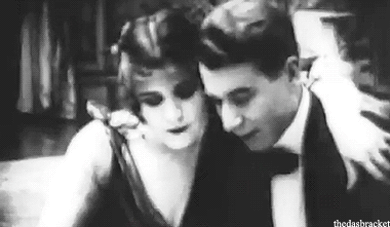
===================================================
The film was adaptation of a play which had a successful run in 1915-16 starring Emily Stevens, a beautiful, respected but neurotic actress who had also made several movies but who would die under suspicious circumstances in 1928 of a probable drug overdose or suicide. The reception to this film was lackluster with then film critic and later author and screenwriter Sally Benson saying; "When I realized that this was a Theda Bara comeback picture and not just one of her old releases I could hardly believe my eyes" and the public was disinterested. There would be no further feature film offers. To be fair this is not really a bad film, merely a mediocre one, and Theda is not bad in it. Plotwise is at least straightforward and avoids the by now tired pitfalls of Sensation stories with their overly complicated plots and confusing number of characters while still keeping some of the essentials of a Sensation story; adultery and secrets among the wealthy. It does however drop the darker elements such as murders and addiction. This is actually rather light hearted which puts it in a difficult grey area; it's not dark enough to be a tragedy, especially as it has a happy ending. At the same time it can hardly be called a comedy as it has no gags and considering it's potentially lurid subject matter it's not even sexy.
In this film Theda basically splits the difference in playing the only two character types she was comfortable with managing to be both a Vamp and a Wronged Woman. It's not that Theda is bad here, she is too professional and has too much screen presence to simply phone-it-in, but she is just no longer believable playing a simplistic character who was never very believable anyway. She is fine at the start as a Wronged Woman, giving her cheating husband the side-eye after finding blush powder on his collar is a nice scene.

A scheming Theda is clearly preferable to the hapless victim of "East Lynne". However after she changes into a Vamp on the prowl in Europe we are expected to accept the central conceit of the Vamp character, that men will gather around her like "moths to her flame" (a phrase the film actually uses) in spite of the fact that even a sympathetic viewer can see that Theda is now a not unattractive but average looking forty year old and not the sultry chainmail bikini wearing temptress of a decade earlier. The film may recognize this in making most of her flock of lovers (except the young architect Lawrence) as being rich and foolish older men but it doesn't stop it from almost seeming like a parody of her earlier roles. This film could have possibly been used to send up Theda's earlier persona and transition to a new more comedic persona as Mae West would do, if only she had been more self-aware and willing to take the risk instead of too obviously trying to rekindle her youth and expecting the audience to go along with the fantasy. As it turned out they were no longer willing to do so.
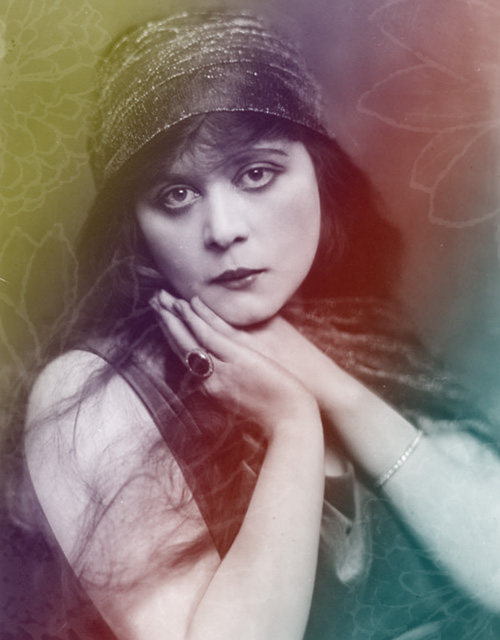
Like her other surviving films the direction is strictly by rote and most of the supporting players are of little note. Director James Young was another journeyman actor and director (married to another early screen sex symbol, Clara Kimbal Young) who had been around since 1914 with dozens of film credits including a version of "Oliver Twist" but had never done anything noteworthy. Chadwick Pictures was a small independent studio sometimes compared to the "Poverty Row" studios of the 1930's and 40's that specialized in low budget comedies, westerns and b-movies. This is not entirely fair as they would make movies starring the likes of Lionel Barrymore including "The Bells" a 1926 Gothic Crime film which also starred a young Boris Karlof, a version of "The Wizard Of Oz" (1926) and the first of the longrunning Boston Blackie detective series and there is nothing wrong with the film's production values with the scenes of the opulent dinner parties showing some promise with their sets and costumes for the dancing girls, at least as far as we can tell from the poor quality of the available print. Cute Eileen Percy as Emily is fine and has some light comedy charm (she would continue acting into the early sound era then took on a second career as a journalist when the parts dried up) although the male characters are all unlikable dullards. Hubert is childish but he is too feckless to be a villain. As in her other surviving films children exist to symbolize innocence as in an early scene where Hubert shows his heedless selfishness by inadvertently stepping on a baby picture. Later of course a child will bring the warring parents together and save their marriage in a plot ending that any Sensation Novelist would have sneered at. Overall this film is still objectively more enjoyable than the dreary "East Lynne" and at least gives us a Theda as a strong character as she should be, but this trip to the now misty past (of only a decade earlier) would not be enough to resurrect her career.
After the failure of this film Charwick Pictures apparently showed no interest in trying again but Theda, who was nothing if not stubborn, accepted an offer from comedy producer Hal Roach to parody her Vamp character in a comedy short directed by Stan Laurel.

MADAME MYSTERIE (1926);
Directed by Stan Laurel
CAST;
Theda Bara as Madame Mysterieux
Tyler Brooke as Hungry artist
James Finlayson as Struggling author
Fred Malatesta as Man of a thousand eyes
Oliver Hardy as Captain Schmaltz
PLOT SYNOPSIS (spolier alert);
Tyler Brooke and James Finlayson are two hapless starving artists in London desperate for cash. Tyler is a painter and James is a writer who is also serving as Tyler's model while dressed in drag. They see Madame Myterieux (Theda Bara), InternationalSpy, in a car being chased by The Man Of 1000 Eyes (Fred Malatesta), another spy and his driver who are disguised as cops. Fred and his driver try to run Theda off the road but their car crashes in front of the artist loft where Tyler and James live and Theda escapes. James and Tyler carry the stunned spies inside where Malatesta, who is cross eyed, wakes up dazed and seeing James in drag thinks he is a woman and flirts with him/her before passing out again. While he is asleep Tyler searches Malatesta's coat and finds a telegram telling Malatesta that Madame Mysterieux is smuggling a valuable object to America and offering a large reward for it's capture. They decide to intercept her themselves and collect the reward. Madame Mysterieux calls the US Embassy and informs them that the object she is smuggling is actually a powerful explosive that resembles a lump of silly putty. Mysterieux drives to the harbour to catch a steamer to New York as Malatesta wakes up and goes after her. Mysterieux boards the ship, the captain of which is the bumbling Captain Schmaltz (Oliver Hardy). Tyler and James arrive as well and Tyler boards but James is refused as he does not like the passport photo that they stole from Malatesta. So James disguises himself by putting his clothes on backwards and wearing a mask. Malatesta arrives at the ship too late to board. On board Tyler and James search for Mysterieux's cabin while dodging Schmaltz but she spots them first. When she confronts them Tyler runs away and Mysterieux lures James to pratfall down a flight of stairs. Malatesta books a seaplane to catch up with the ship and climbs aboard at night to search for Mysterieux. As Mysterieux sleeps Tyler and James drill a hole through her cabin wall to spy on her. While they watch Malatesta also finds her cabin and breaks in to search for the smuggled explosive which he does not find so he starts a fire and hides to see if she reveals the hiding place when she retrieves the package. When she does he confronts her by Tyler grabs the package through the hole they drilled. Mysterieux runs outside and finds Schmaltz who she warns about the fire. As a crowd gathers outside Tyler and James try to hide the small package which James hides in his mouth. Malatesta pulls a gun and fires at Tyler and James who panics and swallows the package. Schmaltz, Mysterieux and a crowd burst in on Tyler and James and she reveals that the package contains an explosive which she calls Helium Nitrate which is powerful enough to destroy the ship. Tyler panics and starts to run away. James reveals that he has swallowed the bomb and is feeling sick and starts to hiccup and stagger around. Malatesta decides to explode the bomb and kicks James in the ass. The bomb activates and James' stomach starts to expand like a balloon. Everybody panics and runs about as James keeps expanding and then starts to levitate into the air like a blimp. Tyler tries to pull him down but both are carried away into the sky. Mysterieux is handed a telegram saying that the explosive has been switched with harmless helium and the actual explosive has been sent ahead to America. As Malatesta tries to read the telegram over her shoulder she hands it to him and walks away. When he reads it he angrily pounds on the ship railing knocking it open and he falls overboard. As James and Tylersoar away a large pelican lands on them and begins pecking at James's extended stomach causing them to explode as Madame Mysterieux waves goodbye. Finis.
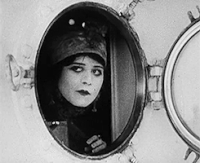
This is a mediocre comedy short typical of Hal Roach Studios and featured regulars like director Stan Laurel, his partner Oliver Hardy and James Finlayson, a balding, beak-nosed, Scottish comic actor with his trademark walrus mustache, popping eyes and air of perpetual outrage and/or confusion known as a comic foil in dozens of comedies by Laurel and Hardy, The Little Rascals, The Keystone Kops, Charley Chase and Ben Turpin. It's full of slapstick, silly disguises and exaggerated double takes from characters who are universally inept. Theda is fine in this as the straight persona and only character who is not an idiot and is able to mock her own persona without sacrificing her genuine charisma and imperious screen presence. This film and her performance raises the question of whether Theda could have reshaped her career as a comic actress. She had also already been used in cartoon form in a 1918 Mutt & Jeff cartoon short. Mae West was carving out a career mocking the character of the Brassy Blonde Dame and there was an opening for Theda to remake herself slightly as a comedy Vamp. Given her specific persona she was perfectly positioned to exploit her own character if she wanted to. She had the talent assuming she was given the right vehicle and director, but aside from a few seconds of a cameo in another 1926 Hal Roach comedy short (the footage for which was actually lifted from this film) this would be her last screen appearance making it an odd swan song. It's likely she simply did not want to do so. Personal accounts of the time present her as a nice lady, generous and professional but she was also rather aloof from Hollywood, not known for her humour and proud of her persona which she had become rather possessive of (an aside; Theda was reportedly extremely near-sighted, "Blind as a bat" according to actress Nita Naldi, but was too vain to wear glasses, at least in public) and if continuing on required mocking that persona, that was not attractive for a woman who took herself quite seriously. By this point however her persona had become a harmless nostalgic joke for most and she would not be getting any more offers for serious romantic or tragic roles. The other option would be to transition to more matronly roles (as Alla Namizova would eventually do) but that was even less appealing to the proud Theda.

Fortunately Theda did not really have to work and while her retirement at age 41 may have been unwilling it was not uncomfortable unlike many of her silent sisters. Alla, Mae Murray and Louise Brooks would end up in relative poverty. Audrey Munson and Mary Fuller would be institutionalized and so for a time would Clara Bow, Florence Lawrence would end up as a suicide, while Clara Bow and eventually Mary Pickford would become recluses never leaving their homes. Theda not only made a lot of money she also kept it and her husband director Charles Brabington would keep working into the thirties. Unlike many of her sisters Theda had always shunned the Hollywood party scene and lived quietly, not at all like her public persona, and the wild Jazz Age had little effect on her. She would busy herself with charitable activities and support some amateur theatre and maintaining her interest in fortune telling and tarot cards while never giving up hope of returning to the screen. Up to her death she continued to list herself in the Hollywood casting directory as being "At Liberty", meaning not under contract but available for offers that would never come. She would give occasional interviews in which she teased out possible film projects which never panned out along with a proposed bio-pic starring Betty Hutton which also never happened. She died of cancer in 1955 aged only 69, Brabington died two years later. She had lived long enough to see almost her entire film catalogue destroyed in a film vault fire at Fox Studios in 1937 but she also knew that her status as film's first great sex queen was secure. In 1958 Life Magazine published a gorgeous set of photos featuring Marilyn Monroe as iconic sex symbols of the past. These also included Clara Bow, Lillian Russell, Jean Harlow and Marlene Dietrich but the Theda pics were the most stunning. Theda would have enjoyed that as did Clara. In the sixties after the mega expensive Elizabeth Taylor version of "Cleopatra", posters of Theda's classic Cleo became popular on the walls of college girls and in the eighties a new generation of Goth Chicks would adopt Theda as their Queen of the Night. And so the eternal Vamp has remained.
THEDA SCREEN TEST;
MARILYN MONROE AS THEDA;
